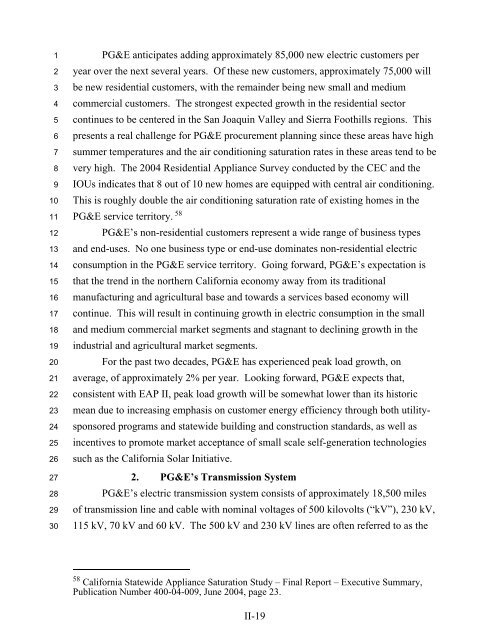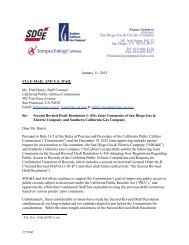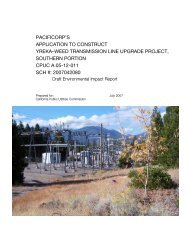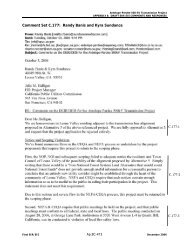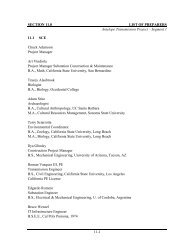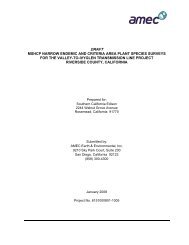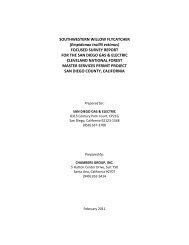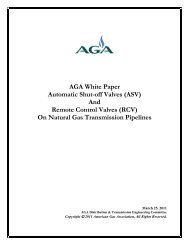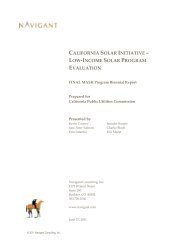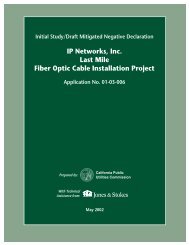Volume I. Part I - California Public Utilities Commission
Volume I. Part I - California Public Utilities Commission
Volume I. Part I - California Public Utilities Commission
Create successful ePaper yourself
Turn your PDF publications into a flip-book with our unique Google optimized e-Paper software.
1<br />
2<br />
3<br />
4<br />
5<br />
6<br />
7<br />
8<br />
9<br />
10<br />
11<br />
12<br />
13<br />
14<br />
15<br />
16<br />
17<br />
18<br />
19<br />
20<br />
21<br />
22<br />
23<br />
24<br />
25<br />
26<br />
27<br />
28<br />
29<br />
30<br />
PG&E anticipates adding approximately 85,000 new electric customers per<br />
year over the next several years. Of these new customers, approximately 75,000 will<br />
be new residential customers, with the remainder being new small and medium<br />
commercial customers. The strongest expected growth in the residential sector<br />
continues to be centered in the San Joaquin Valley and Sierra Foothills regions. This<br />
presents a real challenge for PG&E procurement planning since these areas have high<br />
summer temperatures and the air conditioning saturation rates in these areas tend to be<br />
very high. The 2004 Residential Appliance Survey conducted by the CEC and the<br />
IOUs indicates that 8 out of 10 new homes are equipped with central air conditioning.<br />
This is roughly double the air conditioning saturation rate of existing homes in the<br />
PG&E service territory. 58<br />
PG&E’s non-residential customers represent a wide range of business types<br />
and end-uses. No one business type or end-use dominates non-residential electric<br />
consumption in the PG&E service territory. Going forward, PG&E’s expectation is<br />
that the trend in the northern <strong>California</strong> economy away from its traditional<br />
manufacturing and agricultural base and towards a services based economy will<br />
continue. This will result in continuing growth in electric consumption in the small<br />
and medium commercial market segments and stagnant to declining growth in the<br />
industrial and agricultural market segments.<br />
For the past two decades, PG&E has experienced peak load growth, on<br />
average, of approximately 2% per year. Looking forward, PG&E expects that,<br />
consistent with EAP II, peak load growth will be somewhat lower than its historic<br />
mean due to increasing emphasis on customer energy efficiency through both utility-<br />
sponsored programs and statewide building and construction standards, as well as<br />
incentives to promote market acceptance of small scale self-generation technologies<br />
such as the <strong>California</strong> Solar Initiative.<br />
2. PG&E’s Transmission System<br />
PG&E’s electric transmission system consists of approximately 18,500 miles<br />
of transmission line and cable with nominal voltages of 500 kilovolts (“kV”), 230 kV,<br />
115 kV, 70 kV and 60 kV. The 500 kV and 230 kV lines are often referred to as the<br />
58 <strong>California</strong> Statewide Appliance Saturation Study – Final Report – Executive Summary,<br />
<strong>Public</strong>ation Number 400-04-009, June 2004, page 23.<br />
II-19


